Potential Invader
rhinoceros beetles, elephant beetles
Family: Scarabaeidae Subfamily: Dynastinae Genus: Xylotrupes
none available
The elephant (or rhinoceros) beetles of the genus Xylotrupes are large scarabs ranging in body length between 30.0–80.0 mm (1.18–3.15 in). Members of the genus are uniformly shiny black in color. Males have large bifurcatebifurcate:
a process dividing into two points
horns projecting from both the head and pronotumpronotum:
the dorsal surface of the thorax
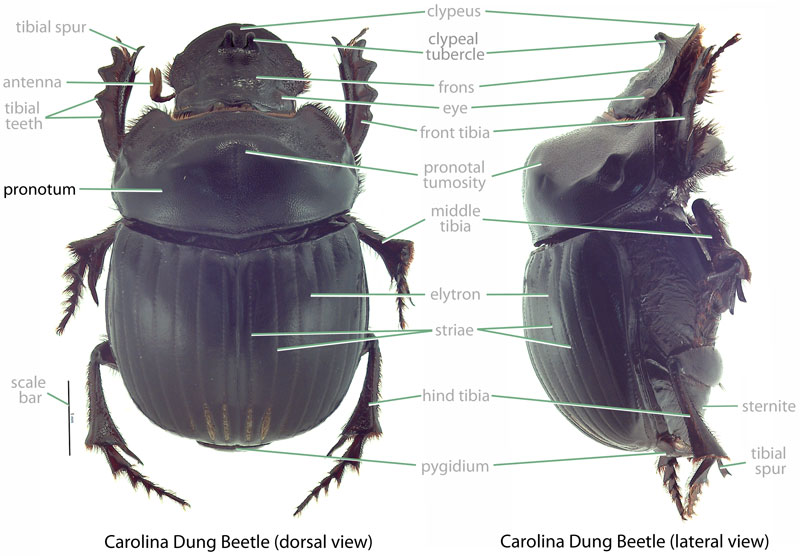 . Females lack the horns of the male (though sometimes have a weak tubercletubercle:
. Females lack the horns of the male (though sometimes have a weak tubercletubercle:
a small, conical knob or horn-like protuberance
) and have a rough, rugoserugose:
having a wrinkled or creased texture or appearance
pronotal surface without an anterioranterior:
the front or forward; opposite of posterior
fovea. Both sexes lack the acutely produced ocular canthuscanthus:
a process extending over and sometimes dividing the eye
observed in the related Trypoxylus scarabs; instead, the ocular canthuscanthus:
a process extending over and sometimes dividing the eye
is rounded or quadratequadrate:
square-like in shape
.
For Xylotrupes ulysses (Bedford, 1974Bedford, 1974:
Bedford G. 1974. Descriptions of the larvae of some rhinoceros beetles (Coleoptera: Scarabaeidae: Dynastinae) associated with coconut palms in New Guinea. Bulletin of Entomological Research. 63: 445–47): Grub C-shaped, not hump-backed, cylindrical, cream-colored. Maxillamaxilla:
set of paired mouthparts located posterior to the mandibles
with galeagalea:
outer branch or lobe of the maxilla
 and lacinialacinia:
and lacinialacinia:
inner portion of the maxilla fused or nearly so. Lacinialacinia:
fused or nearly so. Lacinialacinia:
inner portion of the maxilla of maxillamaxilla:
of maxillamaxilla:
set of paired mouthparts located posterior to the mandibles
with 3 well-developed unciunci:
in scarab larvae, a hooked process on the distal margin of the maxilla
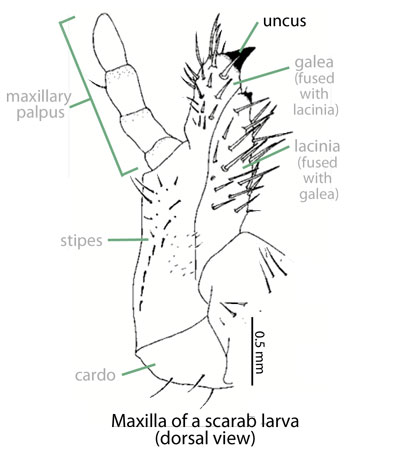 . Maxillary stridulatory area with 11 or 12 blunt teeth. Left mandiblemandible:
. Maxillary stridulatory area with 11 or 12 blunt teeth. Left mandiblemandible:
The crushing or chewing portion of an insects mouthparts
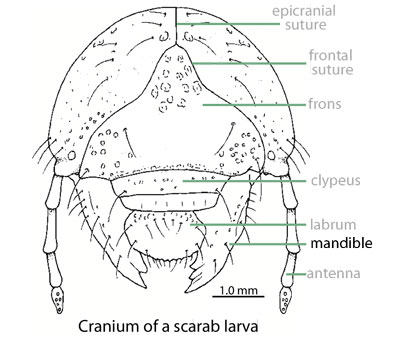 with prominent toothtooth:
with prominent toothtooth:
a pointed process from an appendage or margin, often in reference to the tibia
between molar and scissorial regions. Anterioranterior:
the front or forward; opposite of posterior
frontal angle with 3–6 setaesetae:
small, hair-like structure
. Last antennal segment with 11–18 dorsaldorsal:
of or relating to the upper surface; opposite of ventral
sensory spots. Thoracic spiraclesspiracles:
opening on the abdomen or thorax through which air enters and exits the body
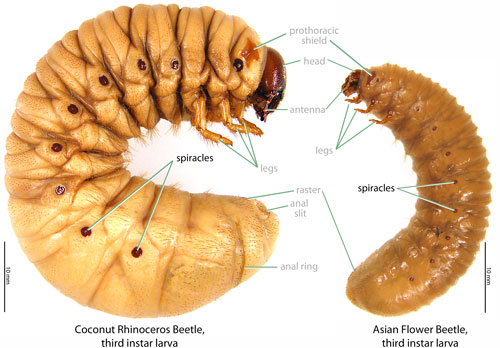 pyriformpyriform:
pyriformpyriform:
pear-shaped
. Legs 4-segmented. Claws each with 3 or four long setaesetae:
small, hair-like structure
. Rasterraster:
in scarab larvae, a complex of setose, spiny, and bare areas on the ventral surface of the last abdominal segment with tegesteges:
with tegesteges:
in larvae, groupings of setae
of 40–80 short, sharp setaesetae:
small, hair-like structure
, surrounded by longer setaesetae:
small, hair-like structure
. Lower anal lip with 80–130 short, sharp setaesetae:
small, hair-like structure
with caudalcaudal:
oriented towards the posterior
border of 100–130 longer setaesetae:
small, hair-like structure
. Anal opening transversetransverse:
extending horizontally across a surface
, straight to slightly curved. PlegmatiaPlegmatia:
in scarab larvae, a paired, lateral region with a somewhat sclerotized surface bordered by marginal spines with acanthoparia
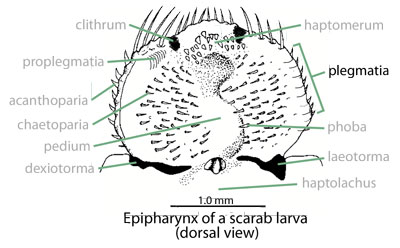 absent.
absent.
Asia and Australia. Species in the genus Xylotrupes have been recorded from Sri Lanka, India, Nepal, Bhutan, Burma, Indochina, China, the Philippines, Malaysia, Indonesia, Australia, Papua New Guinea, the Solomon Islands, and Vanuatu (Rowland, 2003Rowland, 2003:
Rowland J. 2003. Male horn dimorphism, phylogeny and systematics of rhinoceros beetles of the genus Xylotrupes (Scarabaeidae: Coleoptera). Australian Journal of Zoology: 51: 213-258.).
Members of this genus feed upon the bark, sap, and flowers of crops such as coconut (Cocos nucifera), cacao (Theobroma cacao) (Bedford, 1975Bedford, 1975:
Bedford G. 1975. Observations on the biology of Xylotrupes gideon (Coleoptera: Scrabaeidae: Dynastinae) in Melanesia. Journal of the Australian Entomological Society 14: 213-216. full text (accessed 2015)), guava (Psidium guajava) (Firake et al, 2013), and okra (Abelmoschus esculentus) (Nair et al., 2001Nair et al., 2001:
Nair S, Prameela P, Suma A, Cherian K, Babu K. 2001. A new record of Xylotrupes gideon (L.) on okra ( Abelmoschus esculentus [L.]). Insect Environment: 7: 71.). They also have been reported feeding upon ornamental plants including hoop pine (Araucaria cunninghamii), rudraksha (Elaeocarpus sphaericus), rainbow eucalyptus (Eucalyptus deglupta), flame tree (Delonix regia), ash (Fraxinus spp.), jacaranda (Jacaranda mimosifolia), raintree (Samanea spp.), and mahogany (Toona australis) (Bedford, 1975Bedford, 1975:
Bedford G. 1975. Observations on the biology of Xylotrupes gideon (Coleoptera: Scrabaeidae: Dynastinae) in Melanesia. Journal of the Australian Entomological Society 14: 213-216. full text (accessed 2015)).
Elephant beetle larvaelarvae:
the immature form of an insect; in scarabs, also called grub or white grub; preceded by the egg stage, followed by the pupal stage
 develop in moist humushumus:
develop in moist humushumus:
soil rich in organic matter
, rotten wood, or compost. In New Guinea, larvaelarvae:
the immature form of an insect; in scarabs, also called grub or white grub; preceded by the egg stage, followed by the pupal stage
 frequently occur under logs and rotting wood, particularly coconut (Bedford, 1974Bedford, 1974:
frequently occur under logs and rotting wood, particularly coconut (Bedford, 1974Bedford, 1974:
Bedford G. 1974. Descriptions of the larvae of some rhinoceros beetles (Coleoptera: Scarabaeidae: Dynastinae) associated with coconut palms in New Guinea. Bulletin of Entomological Research. 63: 445–47). In captivity, the egg stage lasted an average of 21 days before larval emergence, the first instarinstar:
in scarabs, one of the three larval growth phases (i.e., first instar, second instar, third instar), each ending with the larvae molting to the next phase
lasted 20 days, the second instarinstar:
in scarabs, one of the three larval growth phases (i.e., first instar, second instar, third instar), each ending with the larvae molting to the next phase
lasted 24 days, and the third instarinstar:
in scarabs, one of the three larval growth phases (i.e., first instar, second instar, third instar), each ending with the larvae molting to the next phase
lasted 144 days (Bedford, 1975Bedford, 1975:
Bedford G. 1975. Observations on the biology of Xylotrupes gideon (Coleoptera: Scrabaeidae: Dynastinae) in Melanesia. Journal of the Australian Entomological Society 14: 213-216. full text (accessed 2015)). The pre-pupal stage lasted 14 days, with adults emerging from the true pupapupa:
the intermediate stage between the larva and the adult for insects with complete development
after 32 days. Adult females lived 102 days, slightly longer than the 90-day adult lifespan of males. Adults are attracted to lights (Firake et al., 2013Firake et al., 2013:
Firake D, Deshmukh G, Behere N, Azad-Thakur S, Ngachan S, Rowland J. 2013. First report of elephant beetles in the genus Xylotrupes Hope (Coleoptera: Scarabaeidae) attacking guava. The Coleopterists Bulletin 67: 608-610.) and are likely nocturnal (Bedford, 1975Bedford, 1975:
Bedford G. 1975. Observations on the biology of Xylotrupes gideon (Coleoptera: Scrabaeidae: Dynastinae) in Melanesia. Journal of the Australian Entomological Society 14: 213-216. full text (accessed 2015)). Adults often congregate at feeding locations where competition for mates takes place (Monteith, 2011Monteith, 2011:
Monteith G. 2011. Rhinoceros beetles. Queensland Museum Fact Sheet. full text (pdf automatic download) (accessed 2015)).
Minor. While members of this genus are known to feed on commercially important plants, damage is rarely significant (Monteith, 2011Monteith, 2011:
Monteith G. 2011. Rhinoceros beetles. Queensland Museum Fact Sheet. full text (pdf automatic download) (accessed 2015)). Guava fruits (Firake et al, 2013) and okra pods (Nair et al., 2001Nair et al., 2001:
Nair S, Prameela P, Suma A, Cherian K, Babu K. 2001. A new record of Xylotrupes gideon (L.) on okra ( Abelmoschus esculentus [L.]). Insect Environment: 7: 71.) are both recorded as being damaged by Xylotrupes species. These scarabs also cause occasional damage to palms, but reports of elephant beetles severely damaging palm fronds are likely due to misidentification with somewhat similar looking palm pests, the coconut rhinoceros beetle (Oryctes rhinoceros) and Scapanes australis, the Melanesian rhinoceros beetle (Bedford, 1975Bedford, 1975:
Bedford G. 1975. Observations on the biology of Xylotrupes gideon (Coleoptera: Scrabaeidae: Dynastinae) in Melanesia. Journal of the Australian Entomological Society 14: 213-216. full text (accessed 2015)).
Recorded, not established. This genus has been recorded once in Hawaii. In 1951, a single specimen was collected by a flight attendant in the cabin of a commercial aircraft flying to Honolulu from the Philippines (Hawaiian Entomological Society, 1952BHawaiian Entomological Society, 1952B:
Anonymous. 1952B. Notes and exhibitions. Proceedings of the Hawaiian Entomological Society for the year 1951 14: 363. full text (accessed 2015)).
Not established or recorded. There are no records of this genus from Guam.
Species of Xylotrupes are attracted to lights at night (Firake et al., 2013Firake et al., 2013:
Firake D, Deshmukh G, Behere N, Azad-Thakur S, Ngachan S, Rowland J. 2013. First report of elephant beetles in the genus Xylotrupes Hope (Coleoptera: Scarabaeidae) attacking guava. The Coleopterists Bulletin 67: 608-610.) and could be attracted to well-lit ports and airports. This would allow for hitchhiking on marine or air cargo. Indeed, the specimen recorded in 1951 was found aboard an aircraft. It is worth noting these beetles are popular pets in East Asia (Bouchard, 2014Bouchard, 2014:
Bouchard P. 2014. The Book of Beetles. Chicago, IL: University of Chicago Press.), and intentional transportation may be the most likely means of this species reaching Hawaii or Guam.
These massive scarabs are unlikely to be confused with any other beetle recorded from Hawaii or Guam with the exception of the related Japanese rhinoceros beetle (Trypoxylus dichotomus). These scarab beetles may be separated by examining the male head horn (Xylotrupes with horn bifurcatebifurcate:
a process dividing into two points
[ending in two points] versus T. dichotomuswith horn doubly bifurcatebifurcate:
a process dividing into two points
[ending in four points]), ocular canthuscanthus:
a process extending over and sometimes dividing the eye
in male and female (Xylotrupes with the canthuscanthus:
a process extending over and sometimes dividing the eye
rounded or quadratequadrate:
square-like in shape
versus T. dichotomuswith an acutely produced canthuscanthus:
a process extending over and sometimes dividing the eye
), and female pronotumpronotum:
the dorsal surface of the thorax
 (Xylotrupes lacking a foveafovea:
(Xylotrupes lacking a foveafovea:
a depressed pit or indentation
versus T. dichotomuswith distinct pronotal foveafovea:
a depressed pit or indentation
).
Scarabaeus gideon (Linnaeus)
The 1951 specimen was originaly identified as Xylotrupes gideon. However X. gideon has since been split into a number of species, with more than one occuring in the Phillipines. As such it is impossible to make a species level identification for the Hawaiian record without examining the original specimen.
In Hawaii, this members of this genus represents new invasiveinvasive:
a species that has recently arrived to a new location, usually via human activity, causing notable economic and/or ecological damage
species. Prevent the spread of this species by reporting your observation at our iNaturalist project.